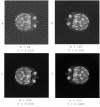Estimating view parameters from random projections for Tomography using spherical MDS
- PMID: 20565859
- PMCID: PMC2898708
- DOI: 10.1186/1471-2342-10-12
Estimating view parameters from random projections for Tomography using spherical MDS
Abstract
Background: During the past decade, the computed tomography has been successfully applied to various fields especially in medicine. The estimation of view angles for projections is necessary in some special applications of tomography, for example, the structuring of viruses using electron microscopy and the compensation of the patient's motion over long scanning period.
Methods: This work introduces a novel approach, based on the spherical multidimensional scaling (sMDS), which transforms the problem of the angle estimation to a sphere constrained embedding problem. The proposed approach views each projection as a high dimensional vector with dimensionality equal to the number of sampling points on the projection. By using SMDS, then each projection vector is embedded onto a 1D sphere which parameterizes the projection with respect to view angles in a globally consistent manner. The parameterized projections are used for the final reconstruction of the image through the inverse radon transform. The entire reconstruction process is non-iterative and computationally efficient.
Results: The effectiveness of the sMDS is verified with various experiments, including the evaluation of the reconstruction quality from different number of projections and resistance to different noise levels. The experimental results demonstrate the efficiency of the proposed method.
Conclusion: Our study provides an effective technique for the solution of 2D tomography with unknown acquisition view angles. The proposed method will be extended to three dimensional reconstructions in our future work. All materials, including source code and demos, are available on https://engineering.purdue.edu/PRECISE/SMDS.
Figures









Similar articles
-
Accurate registration of random radiographic projections based on three spherical references for the purpose of few-view 3D reconstruction.Med Phys. 2008 Feb;35(2):546-55. doi: 10.1118/1.2829865. Med Phys. 2008. PMID: 18383676
-
Structure-from-motion without correspondence from tomographic projections by Bayesian inversion theory.IEEE Trans Med Imaging. 2007 Feb;26(2):238-48. doi: 10.1109/TMI.2006.889740. IEEE Trans Med Imaging. 2007. PMID: 17304737
-
A novel extension of the parallel-beam projection-slice theorem to divergent fan-beam and cone-beam projections.Med Phys. 2005 Mar;32(3):654-65. doi: 10.1118/1.1861792. Med Phys. 2005. PMID: 15839337
-
Iterative reconstruction in cardiac CT.J Cardiovasc Comput Tomogr. 2015 Jul-Aug;9(4):255-63. doi: 10.1016/j.jcct.2015.04.004. Epub 2015 Apr 21. J Cardiovasc Comput Tomogr. 2015. PMID: 26088375 Review.
-
A Survey of the Use of Iterative Reconstruction Algorithms in Electron Microscopy.Biomed Res Int. 2017;2017:6482567. doi: 10.1155/2017/6482567. Epub 2017 Sep 17. Biomed Res Int. 2017. PMID: 29312997 Free PMC article. Review.
Cited by
-
Global geometric affinity for revealing high fidelity protein interaction network.PLoS One. 2011 May 3;6(5):e19349. doi: 10.1371/journal.pone.0019349. PLoS One. 2011. PMID: 21559288 Free PMC article.
References
-
- Hiriyannaiah H. X-ray computed tomography for medical imaging. Signal Processing Magazine, IEEE. 1997;14(2):42–59. doi: 10.1109/79.581370. - DOI
-
- Smith BD. Cone-beam tomography: recent advances and a tutorial review. Optical Engineering. 1990;29
-
- Lewitt RM, Matej S. Overview of Methods for Image Reconstruction From Projections in Emission Computed Tomography. Proceedings Of The IEEE. pp. 1588–1611. - DOI
-
- Yagle AE. A simple non-iterative algorithm for 2-D tomography with unknown view angles. Appeared as a preprint copy. http://www.eecs.umich.edu/~aey/recent/angle.pdf
Publication types
MeSH terms
Grants and funding
LinkOut - more resources
Full Text Sources
Medical
Research Materials
Miscellaneous

